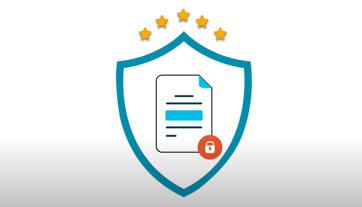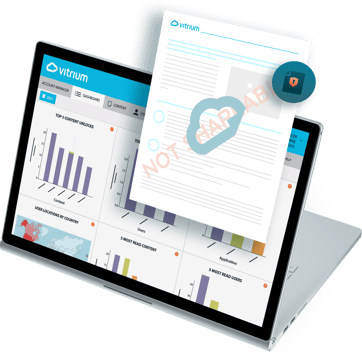DRM is the software that allows organizations to protect their digital content, such as documents, images, PDFs, videos, & audios.
5 Steps to a Secure Document Protection Plan
A document protection plan can help ensure that you are always in complete control of your documents. You can secure and track them. As core elements of a document protection strategy, companies should consider their password policies, the format their documents are in, and the delivery methods they choose for distributing protected documents.
1. Make it a priority, from the top down!
It is essential that all levels of management are aware of the need to protect intellectual property. Understanding the importance of protecting documents, digital assets, files, and sensitive company data, is crucial. It impacts your company's bottom line, and affects the digital safety and operations of your business. Ensure that executives actively promote secure document sharing policies so that it becomes part of the corporate culture, and guide departments and staff so that tools and processes are successfully implemented.
2. Identify your “crown jewels”
The second step to a secure document protection plan is to determine which documents and assets comprise your intellectual property. Think about documents that include sensitive information or that are confidential. Protect documents that can cause revenue loss or damage to your reputation if unlawfully copied or shared. Make a list of these documents and their workflows, and ensure they are thoroughly protected with a quality DRM software.
3. Set a password policy
The ability to set up passwords to safeguard content is just one of the many advantages of comprehensive document protection plans. Choose a password protection solution that “travels with the document” so that no matter where it resides or ends up, the document itself is protected. Moreover, consider advanced password controls. Enforcing strong passwords, limiting failed login attempts, and preventing users from re-using passwords are some of the measures you should take to have a secure document protection plan.
4. Select your document format based on how documents will be accessed
Many companies prefer PDF files because they are a common and familiar format in today’s business environment. More than one billion PDFs exist today, and these files use an open standard that is trusted by many businesses across the globe. These files can be opened on desktops and laptops using Adobe Reader which is standard on most computers.
BYOD, or “bring your own device,” is becoming the standard in companies today. The need for more flexibility in delivering secure documents means that more and more companies are also turning to web-friendly document formats such as HTML5 that can be easily viewed on any device - desktop, laptop, tablet or mobile. And the technology behind HTML5 is ever-improving with more features, tools, and standards being applied. Consider an advanced web viewer option as part of your document protection plan. Allowing your users to access protected documents in a secure web format will give them a better experience while keeping your intellectual property secured.
5. Determine how your documents will be distributed
When you are considering a document protection plan, keep in mind how your users will be accessing your documents, and where. Even if you are sharing documents internally within a secure environment, such as an LMS (learning management system), CMS (content management system), or virtual data room, does the document remain secured when it is sent externally to a customer, vendor or supplier? Consider how that document might be viewed or accessed and whether you can trust their IT network or mobile security program.
Chose a distribution methodology that will offer the end-user a comfort level opening the document on a variety of devices, and document protection that will travel with the document so that no matter where it ends up, you have control over it.
If you want to learn how Vitrium can help with your document protection strategy, don't hesitate to contact us. We'll be happy to answer any questions you may have!
This was an excerpt from our eBook: Top 6 Reasons to Protect Your Documents. If you want to read more, you can download the full eBook here.




